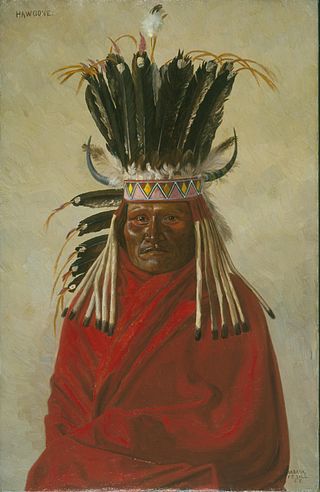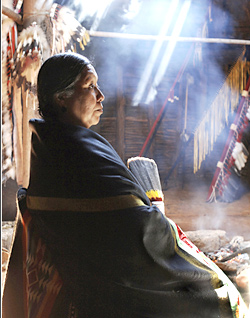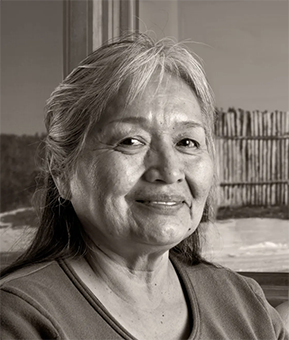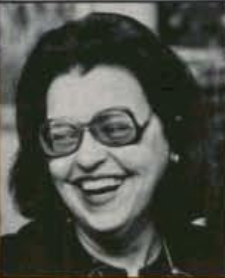Related Research Articles

The Santa Fe Indian Market is an annual art market held in Santa Fe, New Mexico on the weekend following the third Thursday in August. The event draws an estimated 150,000 people to the city from around the world. The Southwestern Association for Indian Arts (SWAIA) organizes the market, showcasing work from 1,200 of the top Native American artists from tribes across the country.

Pablita Velarde born Tse Tsan was an American Pueblo artist and painter.

Charles Sequevya Loloma was a Hopi Native American artist known for his jewelry. He also worked in pottery, painting and ceramics.
Teri Greeves is a Native American beadwork artist, living in Santa Fe, New Mexico. She is enrolled in the Kiowa Indian Tribe of Oklahoma.

Silver Horn or Haungooah (1860–1940) was a Kiowa ledger artist from Oklahoma.

Vanessa Paukeigope Santos Jennings is a Kiowa/Kiowa Apache/Gila River Pima regalia maker, clothing designer, cradleboard maker, and beadwork artist from Oklahoma.

Martha Hopkins Struever (1931–2017) was an American Indian art dealer, author, and leading scholar on historic and contemporary Pueblo Indian pottery and Pueblo and Navajo Indian jewelry. In June 2015, a new gallery in the Wheelwright Museum of the American Indian, was named for her. The first permanent museum gallery devoted to Native American jewelry, the Martha Hopkins Struever Gallery, is part of the Center for the Study of Southwestern Jewelry.

Gail Bird and Yazzie Johnson are Southwest American Indian artists known for their innovative jewelry which uses varied stones and blends both contemporary and prehistoric design motifs.

Otellie Loloma was a Hopi Native American artist, specializing in pottery and dance. Additionally, she worked with her husband Charles Loloma on jewelry design.

Maria Chabot (1913–2001), was an advocate for Native American arts, a rancher, and a friend of Georgia O'Keeffe. She led the restoration of her house in Abiquiú, New Mexico, and took the photograph of O'Keeffe entitled Women Who Rode Away, in which the artist was on the back of a motorcycle driven by Maurice Grosser. Their correspondence was published in the book Maria Chabot—Georgia O'Keeffe: Correspondence 1941-1949.
Diane O’Leary (Opeche-Nah-Se), PhD (1939–2013), was a Native American multimedia artist, half Irish and half Comanche. Her work advocates for the equality and dignity of the oppressed and misused, including Native Americans, women, and the environment. She is most known for her female native figures pieces, combining her scientific education and creative talents to create abstract yet accurate body portraits. O'Leary's latest work was a collage series advocating for the poor environmental state of Oregon's Tillamook Bay.

Jeri Ah-be-hill was a Kiowa fashion expert and art dealer. She owned and operated a trading post on the Wind River Indian Reservation for more than twenty years before moving to Santa Fe, New Mexico where she became the curator of the annual Native American Clothing Contest held at the Santa Fe Indian Market. She also worked as a docent at both the Institute of American Indian Arts and the Wheelwright Museum of the American Indian. Considered an expert on Native American fashion, she traveled nationally presenting educational information about tribal clothing.

Christine McHorse, also known as Christine Nofchissey McHorse, was a Navajo ceramic artist from Santa Fe, New Mexico.

Mamie Deschillie (1920–2010) was a Navajo folk artist.

Valjean McCarty Hessing was a Choctaw painter, who worked in the Bacone flatstyle. Throughout her career, she won 9- awards for her work and was designated a Master Artist by the Five Civilized Tribes Museum in 1976. Her artworks are in collections of the Heard Museum of Phoenix, Arizona; the Philbrook Museum of Art in Tulsa, Oklahoma; the Southern Plains Indian Museum in Anadarko, Oklahoma; and the Wheelwright Museum of the American Indian of Santa Fe, New Mexico, among others.
Margaret Wood is a Navajo-Seminole fiber artist, fashion designer, and quilt maker. Though she began her career as a teacher and librarian, Wood switched to fiber arts to allow her to express her creativity. She published Native American Fashion: Modern Adaptations of Traditional Designs, which for four decades was the only book focused on traditional native clothing and how it was modified in contemporary design. From 1990, Wood primarily became a quilter, displaying her works at numerous featured exhibitions throughout the United States, including such venues as the American Craft Museum in Manhattan; the Heard Museum of Phoenix, Arizona; the Riverside Metropolitan Museum of Riverside, California and the Wheelwright Museum of the American Indian of Santa Fe, New Mexico, among many others.
D.Y. Begay is a Navajo textile artist born into the Tóʼtsohnii Clan and born from the Táchiiʼnii Clan.
Orlando Dugi is a Diné (Navajo) fashion designer. He is a member of the Navajo Nation, and currently lives in Santa Fe, New Mexico.
References
Citations
- 1 2 Pardue 2007, p. 50.
- ↑ McGuire 1981, p. 1J.
- ↑ Little 2017, pp. 38–39.
- 1 2 Little 2017, p. 39.
- 1 2 3 Indyke 2004, pp. 52–54.
- 1 2 Bennett-Begaye 2015, p. 21.
- 1 2 3 Little 2017, p. 40.
- 1 2 Wheelwright Museum 2017.
- ↑ The Santa Fe New Mexican 1990.
- 1 2 3 Little 2017, p. 38.
- 1 2 Little 2017, p. 41.
- ↑ Pardue 2007, pp. 50–51.
- ↑ Little 2017, p. 35.
- ↑ Ataumbi 2018.
- 1 2 Little 2017, p. 36.
- ↑ "Keri Ataumbi". UNUM Magazine.
- 1 2 3 4 Little 2017, p. 37.
- 1 2 Lieber 2016.
- ↑ Little 2017, pp. 37–38.
- ↑ Allaire 2018.
- ↑ Abatemarco 2019.
- ↑ Indian Country Today 2014.
- ↑ "Shiprock Santa Fe Presents Keri Ataumbi & Robert Lee Morris". PRWeb. Retrieved April 23, 2021.
- ↑ "From the Belly of Our Being: Art by and about Native creation - Oklahoma State University". museum.okstate.edu. April 14, 2020. Retrieved April 23, 2021.
- ↑ "Native Fashion Now". pem.org. Retrieved April 23, 2021.
- ↑ "Kiowa-Proud: Sisters in Action: Teri Greeves and Keri Ataumbi | School for Advanced Research" . Retrieved April 23, 2021.
- ↑ "Four Winds Gallery: Keri Ataumbi". Four Winds Gallery. Retrieved April 23, 2021.
Bibliography
- Abatemarco, Michael (April 12, 2019). "Sister act: Artists Keri Ataumbi and Teri Greeves". The Santa Fe New Mexican . Santa Fe, New Mexico. Archived from the original on April 18, 2019. Retrieved August 2, 2019.
- Allaire, Christian (June 27, 2018). "An Interview with Keri Ataumbi: How We Wear Art". fourwindsgallery.com. Pittsburgh, Pennsylvania: Four Winds Gallery. Archived from the original on August 2, 2019. Retrieved August 2, 2019.
- Ataumbi, Keri (2018). "Follow Your Bliss". UNUM Magazine. No. 4. Santa Fe, New Mexico: UNUM, LLC. Archived from the original on August 1, 2019. Retrieved August 2, 2019.
- Bennett-Begaye, Jourdan (May–June 2015). "A Mother's 'Living Treasures'". Native Peoples Magazine. Vol. 28, no. 3. Phoenix, Arizona: Media Concepts Group. pp. 20–22. ISSN 0895-7606 . Retrieved August 1, 2019. – via EBSCO Host (subscription required)
- Indyke, Dottie (July 2004). "Keri Ataumbi". Southwest Art . Vol. 34, no. 2. Richmond, Virginia: Sabot Publishing, Inc. pp. 52–54. ISSN 0192-4214. Archived from the original on September 26, 2015. Retrieved August 2, 2019.
- Lieber, Chavie (January 21, 2016). "The Reclaiming of Native American Fashion". Racked. Washington, D. C.: Vox Media. Archived from the original on January 5, 2018. Retrieved August 2, 2019.
- Little, Carl (July 2017). "Keri Ataumbi: Art to Wear". Ornament. 40 (1). San Marcos, California: Ornament Inc.: 34–41. ISSN 0148-3897 . Retrieved August 1, 2019. – via EBSCO Host (subscription required)
- McGuire, John M. (May 24, 1981). "The White 'Indian': Preserving a Culture in Bronze (pt. 1)". The St. Louis Post-Dispatch . St. Louis, Missouri. p. 1J. Retrieved August 1, 2019– via Newspapers.com. and McGuire, John M. (May 24, 1981). "Richard Greeves (pt. 2)". The St. Louis Post-Dispatch . St. Louis, Missouri. p. 2J. Retrieved August 1, 2019– via Newspapers.com.
- Pardue, Diana (2007). "A New Era in Jewelry: Forging a Future". Ornament. 31 (2). San Marcos, California: Ornament Inc.: 48–51. ISSN 0148-3897 . Retrieved August 2, 2019. – via EBSCO Host (subscription required)
- "Artists › Keri Ataumbi". wheelwright.org. Santa Fe, New Mexico: Wheelwright Museum of the American Indian. 2017. Archived from the original on August 1, 2019. Retrieved August 2, 2019.
- "Petition for Name Change". The Santa Fe New Mexican . Santa Fe, New Mexico. September 17, 1990. p. 15. Retrieved August 1, 2019– via Newspapers.com.
- "Sister Act:Kiowa Artists Keri Ataumbi & Teri Greeves Honored as Living Treasures". News Maven. Washington, D. C. Indian Country Today. December 22, 2014. Archived from the original on August 1, 2019. Retrieved August 2, 2019.
- {{cite news |ref=CITEREFVogue2024 |author= |title=The Poignant Backstory Behind Lily Gladsone's 2024 Met Gala Dress|url=https://www.vogue.com/article/the-poignant-backstory-behind-lily-gladstones-2024-met-gala-dress/
https://www.vogue.com/article/the-poignant-backstory-behind-lily-gladstones-2024-met-gala-dress